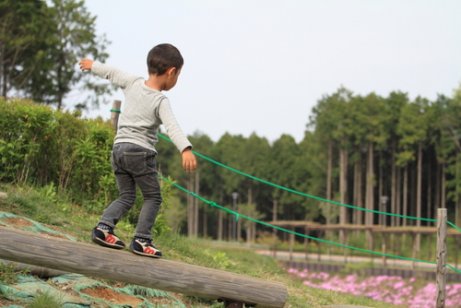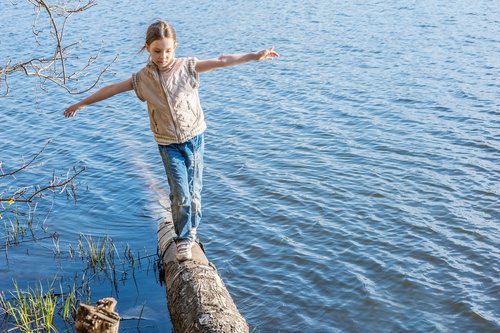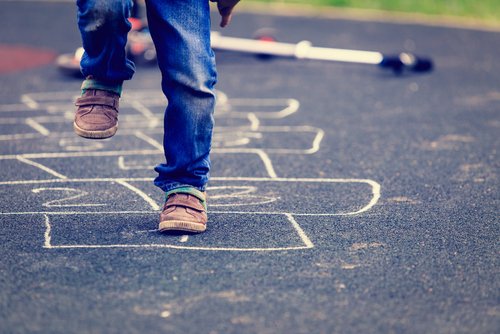7 Tips for Improving Children's Balance

At the same time, they should do them with their eyes open and shut. The proper development of these skills depends on their development of more complex motor abilities.
Children can practice their balance with these activities in order to achieve a better positioning of their bodies in space. The following are just a few exercises that children of different ages can do.
The most effective exercises for improving children’s balance
1. Balancing on one foot
Have your child stand with one foot on the floor and the other over a child-size bench. This is the simplest activity for improving balance on one foot. You can modify the exercise to make it more difficult.
For example, instead of having your child place his or her foot on a bench, you can use a ball. This makes it harder to stay balanced.
2. Balance board
A balance board is a plastic or wooden surface that has a curve below. With one foot on each end of the board, the child tries to keep his or her balance. By just standing upright on the board, children can improve their balance.
3. Walk on colored tape
Stick two parallel lines of colored tape on the floor to simulate a balance beam. During the first attempts, place them about 6 inches apart to establish a wider margin.
Then, to increase the difficulty level, leave only 4 inches between the 2 strips of tape. Have your children walk in the space between the lines, placing one foot in front of the other. If they touch the tape with their feet, they must start over.
Once your child overcomes this challenge, create a balance beam out of wood that is slightly elevated above the floor. To avoid accidents, place cushioning (carpet, exercise mat, etc) around the beam in case your little one falls.

4. Hopscotch
This traditional game is a great exercise for improving balance in children, and it’s also a great way to have fun as a family. Draw a hopscotch on cement using chalk and ask your child to hop through it using only one leg.
You can create variations by allowing your child to use both legs at certain points, or alternating between one and the other.
5. Balancing on a trampoline
Using a trampoline that’s at a safe height for your child, have him or her stand on the trampoline on one foot. To encourage your little one to make a bit more effort, have someone else climb on it and walk around while your child balances.
This is a great activity to boost physical development, and a lot of fun as well.
“Most people feel dizzy now and then. Kids, like adults, may occasionally feel lightheaded or unsteady. But if such feelings repeat or interfere with everyday life, it could be a sign of a balance disorder.”
–National Health Institutes–
6. Exercise balls
Another excellent way to improve one’s balances is to sit on an exercise ball. Challenge children not to put their feet on the floor. If the activity is too easy, give them another activity to do while they hold this position. For example, you can play a board game or card game while your child is seated on the ball.
7. Riding a bicycle
Without a doubt, riding a bike is one of the activities that helps the most when it comes to improving balance. Start out with a bike that’s easy to use and has training wheels. For smaller kids, you can start out with a balance bicycle before moving on to a bike with training wheels.
Once your child has learned the appropriate movements and you feel that he or she is ready, take off the training wheels. You’ll need to stay close by at first to prevent injury and boost confidence. But soon enough, your child will be riding independently.

Modify the above exercises to adequately develop dynamic and static balance in children and improve their spatial relations. The simplest way to do so is ask them to close their eyes while they perform the activities.
These simple activities are useful both at home and at school. They will help guarantee that your child develops basic motor skills that are important for growth. Remember that children’s physical development directly affects their cognitive development.
All cited sources were thoroughly reviewed by our team to ensure their quality, reliability, currency, and validity. The bibliography of this article was considered reliable and of academic or scientific accuracy.
- Caza Coque, L. C. (2022). Guía de ejercicios para el Desarrollo del Equilibrio Dinámico y de la Motricidad Gruesa [Tesis de grado, Universidad Técnica de Cotopaxi, Ecuador]. Archivo digital. Disponible en: http://repositorio.utc.edu.ec/jspui/handle/27000/9025
- Gavilanes Martínez, E. D. C. (2023). Juegos tradicionales en el desarrollo del equilibrio de niños de 4 años. Archivo digital. Disponible en: https://repositorio.uta.edu.ec/handle/123456789/37069
- Guzmán-Muñoz, E., Valdés-Badilla, P., Concha-Cisternas, Y., Méndez-Rebolledo, G., & Sazo-Rodríguez, S. (2017). Influencia del estado nutricional sobre el equilibrio postural en niños: un estudio piloto. Revista Española de Nutrición Humana y Dietética, 21(1), 49-54. Disponible en: https://dialnet.unirioja.es/servlet/articulo?codigo=6051851
- López-Sobaler, A. M., Aparicio, A., Salas-González, M. D., Loria Kohen, V., & Bermejo López, L. M. (2021). Obesidad en la población infantil en España y factores asociados. Nutrición Hospitalaria, 38(SPE2), 27-30. Disponible en: https://scielo.isciii.es/scielo.php?pid=S0212-16112021000500007&script=sci_arttext&tlng=pt
- Mariscal Arcas, M. (2006). Nutrición y actividad física en niños y adolescentes españoles. [Tesis doctoral, Universidad de Granada]. Archivo digital. Disponible en: https://digibug.ugr.es/handle/10481/908
- Mendieta, L., (2019). Incidencia del juego de la rayuela en el desarrollo de la psicomotricidad. Ciencia y Desarrollo, 22(1), 47-67. Disponible en: https://revistas.uap.edu.pe/ojs/index.php/CYD/article/view/1738
- Mischenko, N., Romanova, E., Kolokoltsev, M., Kraynik, V., & Kubiуeva, S. (2021). Fitball as an effective means of strengthening the physical health of preschool children. Educación Física y Ciencia, 23(1), 168-168. Disponible en: https://www.proquest.com/openview/6c251d7e29b79a03734e93204069471e/1?pq-origsite=gscholar&cbl=2045938
- Samaniego, C. V., Sosa, J. M. R., Jiménez, A. R., Borunda, M. S. C., Alonzo, S. J. L., & Torres, R. P. H. (2020). Métodos de evaluación del equilibrio estático y dinámico en niños de 8 a 12 años. Retos: nuevas tendencias en educación física, deporte y recreación, (37), 793-801. Disponible en: https://dialnet.unirioja.es/servlet/articulo?codigo=7243351
- López, E., & Salmerón, M., (2014). El porteo ergonómico. Pediatría Integral. 2014 Nro. 10 66-72. https://www.pediatriaintegral.es/wp-content/uploads/2015/03/Pediatria-Integral-XVIII-10.pdf#page=66